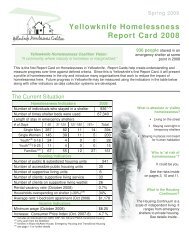The economic dimensions of interpersonal violence - libdoc.who.int ...
The economic dimensions of interpersonal violence - libdoc.who.int ...
The economic dimensions of interpersonal violence - libdoc.who.int ...
- No tags were found...
You also want an ePaper? Increase the reach of your titles
YUMPU automatically turns print PDFs into web optimized ePapers that Google loves.
THE ECONOMIC DIMENSIONS OF INTERPERSONAL VIOLENCE5. ConclusionThis report has reviewed the literature related to the <strong>economic</strong> causes andconsequences <strong>of</strong> <strong><strong>int</strong>erpersonal</strong> <strong>violence</strong>. <strong>The</strong> literature varied both in terms <strong>of</strong>the subject matter addressed and the methodologies employed. This concludingsection <strong>of</strong> the report identifies the main areas <strong>of</strong> difference among the studiesand important gaps in existing research, and po<strong>int</strong>s the way forward to apreliminary research agenda that would standardize definitions, concepts andmethodologies across <strong>economic</strong>, cultural and social settings.5.1 Methodological issues<strong>The</strong> most evident methodological difference among studies <strong>of</strong> the <strong>economic</strong>effects <strong>of</strong> <strong><strong>int</strong>erpersonal</strong> <strong>violence</strong> was the broad range <strong>of</strong> categories <strong>of</strong> costsemployed. Many <strong>of</strong> the differences in <strong>economic</strong> estimates were due to theinclusion or exclusion <strong>of</strong> specific categories <strong>of</strong> costs, rather than to differentapproaches towards counting costs.Another significant difference among studies was the perspective from whichcosts were calculated. <strong>The</strong> majority <strong>of</strong> studies used a societal perspective - inprinciple including all costs and benefits. Several studies, however, included onlycosts to the victims, without counting the social costs <strong>of</strong> prevention, lawenforcement, incarceration and lost productivity. Additionally, the rate used todiscount future costs and benefits ranged from 2.0% to 10% among the studiesreported here (see Chapter 1 for more detail).<strong>The</strong>re are several other important methodological issues that differed across thestudies reviewed in this report. Principal among these were the values assignedto human life, lost productive time and psychological distress. <strong>The</strong> value <strong>of</strong> lifehas been calculated using lost wages, estimates <strong>of</strong> the quality <strong>of</strong> life, wagepremiums for risky jobs, willingness to pay for safety measures and individualbehaviours related to safety measures. <strong>The</strong> values used among studies based <strong>int</strong>he USA ranged from $3.1 million to $6.8 million (Box 1).Quantification <strong>of</strong> the <strong>economic</strong> costs in terms <strong>of</strong> lost human capital is thepredominant approach towards the <strong>economic</strong> evaluation <strong>of</strong> <strong><strong>int</strong>erpersonal</strong><strong>violence</strong> and other public health problems and <strong>int</strong>erventions - but this techniqueis not uncontroversial. By valuing lost time, whether due to incapacitation or tomortality, in terms <strong>of</strong> potential earnings lost the human capital approach appliesa free market to value human life. As a consequence, in a straight comparison,<strong>violence</strong> that kills or maims residents <strong>of</strong> high-income countries would be42
















